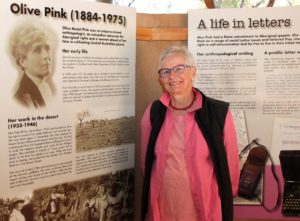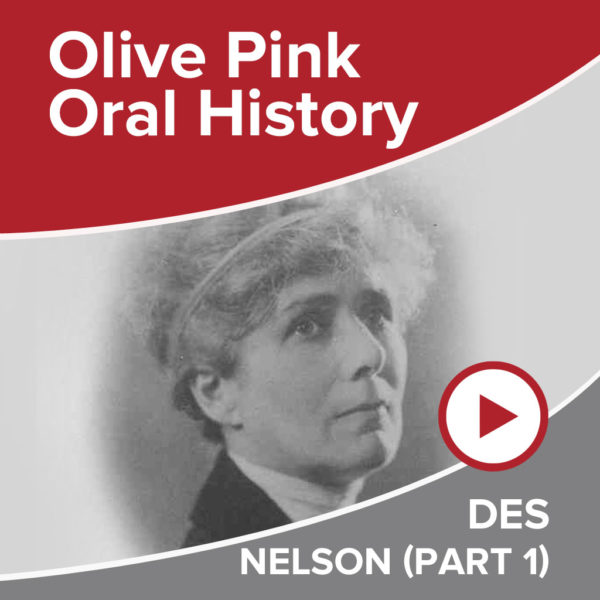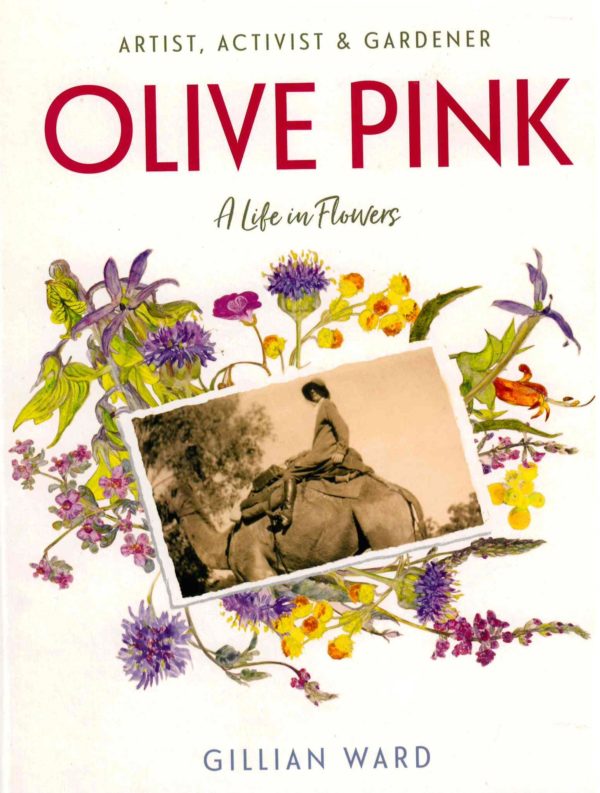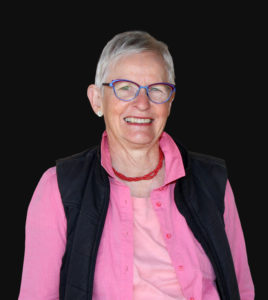Olive Pink Opera – the story
 The Olive Pink Opera, performed under the stars in the Olive Pink Botanic Garden, explores and celebrates the last decade of Olive’s extraordinary life as a painter, anthropologist, botanist, and social activist on behalf of the Warlpiri and Arrernte people of the Alice Springs region.
The Olive Pink Opera, performed under the stars in the Olive Pink Botanic Garden, explores and celebrates the last decade of Olive’s extraordinary life as a painter, anthropologist, botanist, and social activist on behalf of the Warlpiri and Arrernte people of the Alice Springs region.
Olive, who was born in 1886 and died in 1975, devoted her life to Central Australia, recognising the special qualities of its people and its flora. In 1956, she was granted permission to establish her hut and a garden on land that is now the Olive Pink Botanic Garden, and in 1962 she employed a Warlpiri man, Johnny Jampijinpa, to help with work in the garden.
The opera begins with a welcome to country and the Central Australian Aboriginal Women’s Choir singing a blessing Jesu Ngananala (‘Jesus Stand Among Us’), which is an invocation to the ‘Creative Holy Spirit’. This leads into Olive’s Dream when her nemesis, Ted Strehlow, makes an unwelcome appearance alongside her dear friend and mentor Daisy Bates, with whom she spent time in 1927 at Ooldea, an Aboriginal community in remote South Australia.
Strehlow grew up at the Hermannsburg Mission and, as a linguist, collected songs and information about sacred ceremonies of the Aboriginal people. He regarded Olive as an obstructive, unqualified anthropologist who, as a woman, could not possibly have had access to secret men’s knowledge.
The dream scene concludes with the Central Australian Aboriginal Women’s Choir singing the chorale Myatja altimani mununi minala.
Scene Two celebrates Olive’s relationships with the people of Alice Springs, particularly its children. The inspiration for this was an incident when a group of ‘Gap Kids’ let a mob of horses into her garden, which caused havoc, after which Olive chased the children with her saltpetre gun.
At the Interlude, the Central Australian Aboriginal Women’s Choir sing a verse of the Nicolai Chorale Kaarrerrai wurlamparinyai (‘Sleepers Awake’).
In Scene Three, Olive hosts a tea party to celebrate the recent engagement of her friends, botanist Des Nelson and Pat Colley, who bring native plants for the garden she is establishing. Olive explains that some plants are dead because the person she has named them after has fallen out of her favour; another plant, named for Sir Paul Hasluck, continues to be watered as he supported the establishment of the garden.
After farewelling her tea party guests, Olive sings her final soliloquy as she reminisces about her life and watches the sun set over the MacDonnell Ranges. As a fitting finale for a life passionately lived, a lamenting shakuhachi (bamboo flute) leads into the final chorale by the Central Australian Aboriginal Women’s Choir which then fades into the night sounds of the garden.
Johnny Jampijinpa continues to tend the plants.
COMPOSER’S NOTE
Australian Prime Minster Kevin Rudd’s 2008 national apology to the ‘stolen generations’ – Aboriginal and Torres Strait Islander children forcibly removed from their families under different State policies since the beginning of the European occupation of Australia – inspired me to research historical figures who worked closely with Aboriginal people and whose stories might be told in opera. Three women, all of whom knew each other, seemed ideal: Daisy Bates, Olive Pink and Annie Lock. Mparntwe Arrernte Custodian Doris Stuart Kngwarreye says: “The story of Olive Pink is a story that can be shared by Aboriginal and non-Aboriginal people. When people have something in common, they respect each other and listen to each other. That is why telling this story is important to Alice Springs.” (Doris Stuart 14/11/2018).
Olive Pink left a lasting legacy in what is now the Olive Pink Botanic Garden, dedicated to the preservation of desert plants. She created the original Australian Arid Regions Flora Reserve with the help of her Warlpiri gardener Johnny Jampijinpa and wished to call it Alchera-Jugulba, honouring the ancestral origin stories of Arrernte and Warlpiri people alike. She would likely be displeased that it is named in her honour, yet her spirit imbues it to this day. In the opera, this beautiful garden is given musical representation; a living character in its own right, offering not only the setting, but its colours, shapes, sounds and smells in recurring musical textures throughout the work. Olive’s spirit is captured particularly in the sound of the shakuhachi (Japanese bamboo flute), soaring above the rest of the ensemble.
Composer
The Olive Pink Opera is the second of Anne Boyd’s trilogy of music theatre works on significant Australian women who worked closely with Aboriginal people – Daisy Bates, Olive Pink and Annie Lock. An award-winning and prodigious composer, Anne has enjoyed a distinguished career as a music educator, graduating from the University of Sydney (BA Hons) and the University of York (PhD in composition). A strong advocate for equality of women in academia, she was the first woman to be appointed Professor of Music at the University of Sydney, after heading the Department of Music at the University of Hong Kong and teaching at the University of Sussex. Anne’s music is strongly influenced by landscape and Aboriginal and Asian traditions of storytelling. Her compositions are featured in many international music festivals, including the prize-winning Vale of Glamorgan Festival in Wales (2001, 2006, 2012). Edinburgh (1974), Warsaw (1974), Adelaide (1966, 1968, 2002), and Canberra (2016).
Stories about Olive Pink

Seventeen fascinating oral history stories, told by people who interacted with Olive during her life,
can be listened to here.
https://opbg.com.au/the-garden/fact-files/?tx_topics=stories

The story of Olive Pink, an artist, activist and gardener, is told through her association with flowers in this wonderful book by Gillian Ward. The book tells her life’s history and showcases many of her wildflower paintings.
The 248 page book, in full colour, is available from Olive Pink Botanic Garden.

